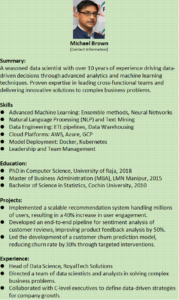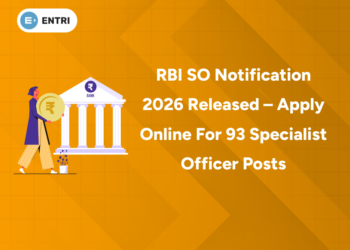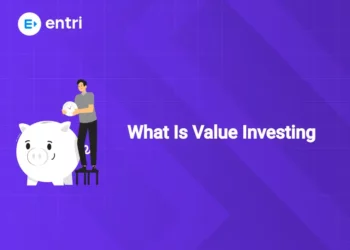Table of Contents
In 2024, data scientists will be very much needed. Being a data scientist requires strong analysis, results focus, and number skills. If you show these on your resume, you’re likely to succeed in this job. To help you write your data science resume, here are five examples to inspire you. In this article, we will discuss “Data Scientist Resume Examples & Tips for 2024.”
Your resume is like your ticket to success as a data scientist. It opens doors for jobs in this fast-growing field. This blog will teach you how to make an impressive data scientist resume. We’ll use industry knowledge and special techniques to help you stand out.
Get hands-on with our data science and machine learning course – sign up for a free demo!
Data Scientist Resume Examples & Tips for 2024
Discussed in this section are some essential tips that you can follow while creating your resume:
Choose a Suitable Template:
When choosing a format to build your resume, consider your experiences, strengths, and the industry standards. Here are some common formats to consider:
Reverse Chronological Format:
- This is the most widely used format.
- It lists your work experiences in reverse chronological order, starting with the most recent job.
- Effective for showcasing a clear career progression and highlighting relevant experience.
Functional Format:
- Focuses on skills and abilities rather than a chronological work history.
- Suitable for career changers, individuals with employment gaps, or those emphasizing skills gained from various roles.
- Organizes sections by skills, achievements, and qualifications rather than specific job positions.
Combination/Hybrid Format:
- Blends elements of both chronological and functional formats.
- Highlights skills and accomplishments while also providing a chronological work history.
- Useful for emphasizing specific skills while showcasing steady career growth.
Targeted Format:
- Customized for a specific job or industry by emphasizing experiences and skills directly relevant to the role.
- Focuses on tailoring the resume to match the job description and requirements.
When choosing a format, consider the following tips:
Picking the right way to arrange your data scientist resume matters. It helps highlight your skills better. The reverse chronological format is commonly used. In this style, your latest work experience comes first. It’s great for those with lots of experience.
If your work history isn’t strong but you have good skills, try a functional resume format. It’s useful if you have job gaps. You can also use a combo resume to get benefits from both formats.
Mention your Objective/Summary
The objective or summary section of your resume is a concise yet impactful statement that introduces you to the potential employer and highlights your career goals, skills, and what you can offer to the organization. Here’s what you can include in your objective/summary:
When you’re new to the data science field, you can still land a job by creating an impressive resume. Using a functional layout for your resume can help. This format focuses more on your skills rather than your work experience. Highlight the skills that match what the company is looking for. Include any internships or voluntary projects you’ve done. Also, sharing your GitHub profile link is a great idea. It allows recruiters to see the projects you’ve worked on. By presenting yourself well and showcasing your skills, you can grab the attention of recruiters and make a strong impression, even without prior experience.
As a pro, go for the reverse chronological format. It lets you show off your work experience in detail. You can highlight all your data scientist jobs.
In your resume, the data science career objective shows why you’re a good fit for the job. It’s like a peek into your career story. It explains why you want that job and what makes your skills special.
Make your summary short and specific to the job you want. Show your qualifications to prove you’re the right fit. Employers want the right people for their company. Tailoring your summary for each company matters a lot.
What to Include in your Resume
Profile:
- Your profile is like a short story about why you’re a good fit for the Data Scientist role.
- Tell why you’re excited about the job, especially if you’re switching careers into data science.
- This section helps show your enthusiasm and interest, especially when a cover letter isn’t required.
Work Experience:
- List your recent jobs in data science first.
- Mention your job title, company, how long you worked there, and your main accomplishments.
- Try to describe two or three things you did in each role.
Achievements:
- Focus on what you achieved in your data science projects instead of just what you did.
- Use numbers if possible to show how successful you were.
- For example, say “Predicted company sales with 95% accuracy” instead of just “Forecasted company sales.”
Education:
- Start with your most recent education.
- List degrees even if they’re not in data science.
- Also, include any extra courses, certificates, or academic accomplishments that might be relevant.
Projects:
- Show the data science projects you’ve worked on. Include the project title, a link if possible, and your role.
- Explain a bit about the project and mention any tools or skills you used.
Skills:
- List your technical skills related to data science.
- Put your strongest skills at the top. Match these skills with what the job description asks for.
Extras:
- This part is for extra things that make you special.
- Talk about conferences you’ve been to, any articles or awards you got, your hobbies or interests related to data science, and any events you participated in, like hackathons.
- These things show your passion and commitment as a Data Scientist.
What Skills Should be Mention in a Data Science Resume
Your data science resume needs the right technical skills for the job. First, list all your data skills and tools. Then, match them with what the job needs from its description. Add extra skills that can make you stand out.
Key Data Scientist skills include:
- Understanding technical data
- Analyzing data
- Organizing data
- Creating data models
- Using statistics Visualizing data Programming
- Doing quantitative analysis
- Applying machine learning
- Building machine learning models
- Digging into data Fixing issues
- Testing hypotheses
- Running A/B tests
- Using regression
Tools and Languages:
- R Python
- C
- C++
- C#
- HTML
- Java
- JavaScript
- PHP
- SAS
- SQL
- Scala
- MATLAB
- SQL Server
- NoSQL
- Hadoop
- OpenRefine
- TensorFlow
- Cloudera
- Tableau
- Microsoft Excel
- Octave
- Spark
- Power BI
- Plotly
- Bokeh
- Matplotlib
- Seaborn
- Keras
- Pytorch
- AWS Hive
Sample Data Science Resume Format
Given below are three sample resumes for your reference
Entry-Level Data Scientist Resume
1: Which of the following algorithms is most suitable for classification tasks?
Mid-Level Data Scientist Resume
 Senior-Level Data Scientist Resume
Senior-Level Data Scientist Resume
🚀 Start Coding Today! Enroll Now with Easy EMI Options. 💳✨
Equip yourself with in-demand skills to land top-tier roles in the data-driven world.
Start Learning Now with EMI OptionsConclusion:
Data Scientist Resume Examples & Tips for 2024 was discussed successfully. The aim of your resume is to highlight your skills, experience, and achievements in a way that makes you stand out as a qualified data scientist. Continuously update and tailor your resume for different positions to increase your chances of landing interviews in 2024 and beyond.
Data Scientist Resume Examples & Tips for 2024: FAQs?
1. How can I make my Data Scientist resume stand out?
- Customize your resume for each job by focusing on skills and experiences that match the job description.
- Show what you achieved in previous roles to highlight your impact.
- Mention the latest tools or technologies you’re familiar with in the field.
2. Is a summary or objective important in a Data Scientist resume?
- Yes, a summary or objective helps quickly tell the employer why you’re a good fit.
- Keep it short and describe what you’re good at and what you offer.
3. Should I include all my work experience?
- Feature jobs related to data science.
- If past jobs aren’t related, highlight skills that can be useful in data science.
4. What skills should I highlight?
- Technical skills like programming, machine learning, data visualization, and databases.
- Soft skills like problem-solving, communication, and teamwork.
- Skills specific to the industry you’re applying to.
5. Do I need to show personal projects?
- It can be helpful, especially for new roles or to display extra skills.
- Projects show how you use your skills and passion for data science.
6. How long should my resume be?
- Keep it short but include key information.
- Usually one to two pages is good enough.
7. What’s important in the education section?
- Start with your highest degree and mention any relevant courses or certifications.
- Add any academic achievements that stand out.
8. Should I mention non-technical skills?
- Yes, include them! Things like problem-solving and communication are vital in data science.
- Show you’re well-rounded with both technical and non-technical skills.
9. Do I need industry-specific words?
- Yes, use words from the job description.
- They help your resume get noticed by companies.
10. How can I make my resume suitable for remote or hybrid jobs?
- Mention any remote work experience or projects done remotely.
- Show you’re good at working independently and can communicate well, which is essential for remote or hybrid jobs.
Get hands-on with our data science and machine learning course – sign up for a free demo!
Get a complete learning experience in data science covering all the basics and tools. Expert professors guide you through real projects, whether you’re a beginner or an experienced pro. Gain skills in data analysis, machine learning, and data visualization. Plus, get internship and placement support for a job-ready graduation.


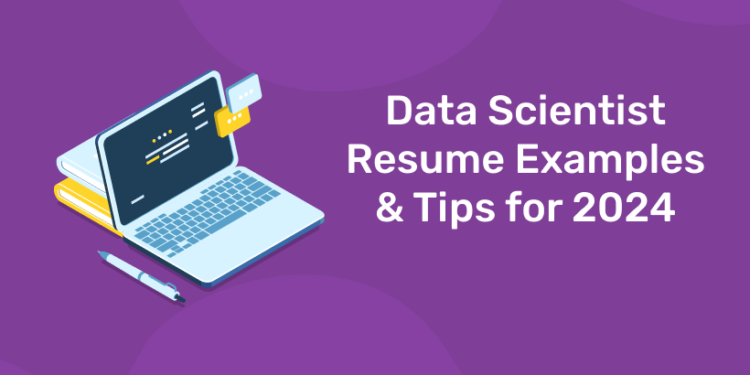
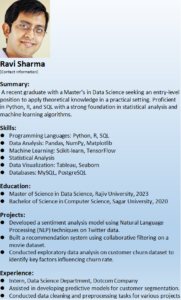
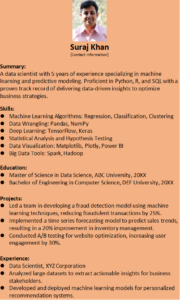 Senior-Level Data Scientist Resume
Senior-Level Data Scientist Resume